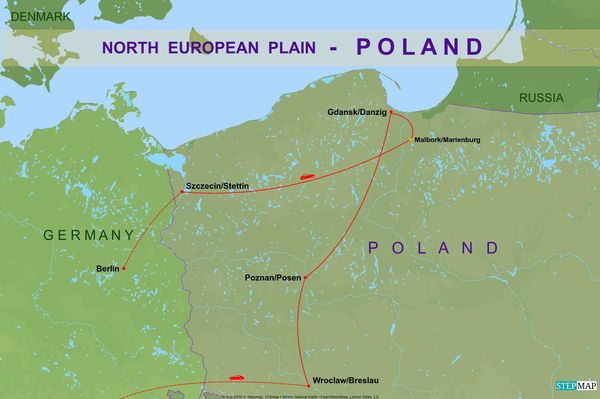North European Plain 83 - Poland/Gdansk|Danzig 1 - Introduction/Early morning sights
Jul 10, 2021 10:54:14 #
While Gdansk was actually embedded earlier in our drive and we visited the city between our stops in Malbork and Poznan, given the importance, but also beauty of this city, I decided to deviate from a strict chronological presentation of our tour and to instead show the images of Gdansk at the very end. Thus the following sets are the last chapter of our tour through these very interesting plains of Northern Europe.
INTRODUCTION
LOCATION - Gdansk is located on the Baltic coast of northern Poland. With a population of 470,000, Gdansk is the capital and largest city of the Pomeranian province and the most prominent city in the geographical region of Pomerania. It is Poland's principal seaport and the center of the country's fourth-largest metropolitan area. The city is situated on the southern edge of Gdansk Bay on the Baltic Sea, in a conurbation with the city of Gdynia, the resort town of Sopot, and suburban communities; these form a metropolitan area called the Tricity, with a population of approximately 1.5 million. Gdansk lies at the mouth of the Motlawa River, connected via the delta to the nearby Vistula River, which drains 60 percent of Poland and connects Gdansk with the Polish capital, Warsaw. Together with the nearby port of Gdynia, Gdansk is also a notable industrial center.
BRIEF HISTORY - The city's history is complex, with periods of Polish, Prussian and German rule, and periods of autonomy or self-rule as a free city state. In the early-modern age, Gdansk was a royal city of Poland. It was considered the wealthiest and the largest city of Poland, before the 18th century rapid growth of Warsaw. In the late Middle Ages it was an important seaport and shipbuilding town and, in the 14th and 15th centuries, a member of the Hanseatic League. During the interwar period Gdansk lay in a disputed region between Poland and Germany, which became known as the Polish Corridor. The city's ambiguous political status was exploited by Germany, furthering tension between the two countries, which would ultimately culminate in the "Invasion of Poland" and the first clash of the Second World War just outside the city limits, followed by the ethnic cleansing and executions of the Polish-speaking minority population and ultimately flight and expulsion of the German-speaking majority of the city's population in 1945. In the 1980s, Gdansk was the birthplace of the Solidarity movement, which played a major role in bringing an end to communist rule in Poland and helped precipitate the collapse of the Eastern Bloc, the fall of the Berlin Wall and the dissolution of the Warsaw Pact. (See more details below - if you are so inclined).
ARTS, CULTURE, TRADE - Gdansk is home to the University of Gdansk, Gdansk University of Technology, the National Museum, the Gdansk Shakespeare Theater, the Museum of the Second World War, the Polish Baltic Philharmonic and the European Solidarity Center. The city also hosts St. Dominic's Fair, which dates back to 1260 and is regarded as one of the biggest trade and cultural events in Europe. Gdansk has also topped rankings for the quality of life, safety and living standards worldwide.
HISTORY OF GDANSK
EARLY POLAND - The first written record thought to refer to Gdansk is the "Vita of Saint Adalbert". Written in 999, it describes how in 997 Saint Adalbert of Prague baptized the inhabitants of urbs Gyddannyzc, "which separated the great realm of the duke [i.e. Boleslaw the Brave of Poland] from the sea." No further written sources exist for the 10th and 11th centuries. Based on the date in Adalbert's vita, the city celebrated its millennial anniversary in 1997. Archaeological evidence for the origins of the town was retrieved mostly after WWII had laid 90 percent of the city center in ruins, enabling excavations. The oldest seventeen settlement levels were dated to between 980 and 1308. It is generally thought that Mieszko I of Poland erected a stronghold on the site in the 980s, thereby connecting the Polish state ruled by the Piast dynasty with the trade routes of the Baltic Sea. Traces of buildings and housing from the 10th century have been found in archaeological excavations of the city.
POMERANIAN POLAND - The site consisted of a settlement at the modern Long Market, settlements of craftsmen along the Old Ditch and German merchant settlements around St Nicholas's church. From 1224 a German market settlement with merchants from Lübeck existed in the area of today's Long Market, as the merchants were invited as immigrants with specific privileges, but were soon (in 1238) forced to leave during a war between the duke and the Teutonic Knights, during which Lübeck supported the latter. Migration of merchants to the town resumed in 1257. Significant German influence only reappeared in the 14th century, after the city was taken over by the Teutonic Knights. In 1263 the town was granted city rights with an autonomy charter similar to that of Lübeck. In 1300, the town had a population of 2,000. While overall the town was not an important trade center, it had some relevance in the trade with Eastern Europe. The city was taken by Danish princes in 1301 and the Teutonic Knights were hired by the Polish nobles to drive out the Danes.
KINGDOM OF POLAND - The Vistula-borne trade of goods in Poland was the main source of prosperity during the city's Golden Age. In 1440, the city participated in the foundation of the Prussian Confederation which was an organization opposed to the rule of the Teutonic Knights. The organization mentioned repeated cases in which the Teutonic Knights imprisoned or murdered local patricians and mayors without a court verdict. Upon the request of the organization, King Casimir IV of Poland reincorporated the territory to the Kingdom of Poland in 1454. This led to the Thirteen Years' War between Poland and the State of the Teutonic Order (1454–1466). Since 1454, the city was authorized by the King to mint Polish coins. The city pledged allegiance to the King in June 1454, declaring the prior Teutonic annexation and rule as unlawful. In 1457 the city gained its rights as an autonomous city, after the king had been invited by the town and had already stayed in town for five weeks. This privilege removed tariffs and taxes on trade within Poland, Lithuania and Ruthenia (present day Belarus and Ukraine) and conferred on the town independent jurisdiction, legislation and administration of her territory, as well as the right to mint its own coin. Gaining privileged access to Polish markets, the seaport prospered while simultaneously trading with the other Hanseatic cities. After the Union of Lublin between Poland and Lithuania in 1569, the city continued to enjoy a large degree of internal autonomy. Around 1640, Johannes Hevelius established his astronomical observatory in the Old Town. The Polish king regularly visited Hevelius. Beside a majority of German-speakers, the city was home to a large number of Polish-speaking Poles, Jewish Poles, Latvians, Flemings and Dutch. In addition, a number of Scots received the city's citizenship. During the Protestant Reformation, most German-speaking inhabitants adopted Lutheranism. Due to the special status of the city and significance within the Polish–Lithuanian Commonwealth, the city inhabitants largely became bi-cultural sharing both Polish and German culture and were strongly attached to the traditions of the Polish–Lithuanian Commonwealth. The city suffered a last great plague and a slow economic decline due to the wars of the 18th century. It was taken by the Russians after the Siege of Danzig in 1734.
PRUSSIA & GERMANY - Danzig was annexed by the Kingdom of Prussia in 1793 in the Second Partition of Poland. Both the Polish and the German-speaking population largely opposed the Prussian annexation and wished the city to remain Polish. An attempted student uprising against Prussia was crushed quickly by the authorities in 1797. During the Napoleonic era Danzig became a free city from 1807 to 1814. In 1815, after France's defeat in the Napoleonic Wars, it again became part of Prussia and the capital of the Danzig region within the province of West Prussia. With the unification of Germany in 1871 under Prussian hegemony, the city became part of the German Empire and remained so until 1919, after Germany's defeat in World War I.
INTER-WARS & WORLD WAR II - The information here is vast, I will condense it to just a few points and, if you are really interested, encourage you to look up more thereof under "Gdansk" in Wikipedia or other online sources. - Gdansk became a "Free City" after World War I, an independent quasi-state under the auspices of the League of Nations. Gdansk also had its own constitution, anthem, parliament and government and issued its own stamps and currency. With the growth of Nazism among Germans, Anti-Polish sentiment increased, in the 1930s the rights of local Poles were commonly violated by the local administration. From 1937, the employment of Poles by German companies was prohibited, and already employed Poles were fired, the use of Polish in public places was banned and Poles were not allowed to enter several restaurants. The German government officially demanded the return of Danzig to Germany along with an extraterritorial highway through the area for land-based access from the rest of Germany. After the German proposals to solve the main issues peacefully were refused, German-Polish relations rapidly deteriorated. Germany attacked Poland on September 1, 1939 after it signed in late August a non-aggression pact with the Soviet Union (which included a secret part regarding the division of Poland and the Baltic States). About 50% of the Jewish Community had left the city within a year after the pogrom in October 1937. By September 1939 barely 1,700 mostly elderly Jews remained; in early 1941, just 600 Jews still lived in the city, most of whom were later murdered in the Holocaust.
In 1941, Hitler ordered the invasion of the Soviet Union, eventually causing the fortunes of war to turn against Germany. As the Soviet Army advanced in 1944, German populations in Central and Eastern Europe took flight, starting the great population shift. After the final Soviet offensives in January 1945, hundreds of thousands of German refugees converged on Danzig, some tried to escape through the city's port in a large-scale evacuation involving hundreds of German cargo and passenger ships, some of these were sunk by the Soviets. Tens of thousands of refugees were killed. The city also endured heavy Allied and Soviet air raids. Those who survived and could not escape had to face the Soviet Army, which captured the heavily damaged city on March 30 1945, followed by large-scale rape and looting. In line with the decisions made by the Allies at the Yalta and Potsdam conferences, the city was integrated with Poland. The remaining German residents of the city who had survived the war fled or were expelled to postwar Germany. The city was repopulated by ethnic Poles, many of them deported by the Soviets from formerly Polish areas annexed by the Soviet Union in the eastern portion of pre-war Poland.
CONTEMPORARY TIMES - Parts of the historic old city of Gdansk, which had suffered large-scale destruction during the war, were rebuilt during the 1950s and 1960s. The reconstruction was not tied to the city's pre-war appearance, but instead was politically motivated as a means of culturally cleansing and destroying all traces of German influence from the city. Any traces of German tradition were ignored by the communists, suppressed or regarded as "Prussian barbarism" only worthy of demolition, while communist and Flemish/Dutch, Italian and French influences were used to replace the historically accurate Germanic architecture which the city was built upon since the 14th century. Boosted by heavy investment in the development of its port and three major shipyards for Soviet ambitions in the Baltic region, Gdansk became the major shipping and industrial center of the People's Republic of Poland. In December 1970, Gdansk was the scene of anti-regime demonstrations, which led to the downfall of Poland's communist leader Gomułka. During the demonstrations in Gdansk, military as well as the police opened fire on the demonstrators causing several dozen deaths. Ten years later, in August 1980, Gdansk Shipyard was the birthplace of the Solidarity trade union movement, which held its first national congress with more than 800 participating deputies in Gdansk. Its opposition to the Communist regime led to the end of Communist Party rule in 1989, and sparked a series of protests that overthrew the Communist regimes of the former Soviet bloc. Solidarity's leader, Lech Walesa, became President of Poland in 1990.
--------------------------------------------------------------------------------------------------------------------------------
In this first set of images of Gdansk, I provide my customary introduction image incorporating a brief text plus a map of the city indicating the places visited during our stay. Then we start with a rather early morning walk shortly after 7 am from our hotel along the marina towards the Motlawa river.
Notes
TRIP INFO: Set # 1 provides a brief introduction, maps and information for the entire series. Find it at:
https://www.uglyhedgehog.com/t-693834-1.html
DETAILS ON POLAND: Set 56 provides an intro, see: https://www.uglyhedgehog.com/t-700547-1.html
EARLIER POSTS of this series: Access my topic list, the new posts are listed in reverse chronological order:
https://www.uglyhedgehog.com/user-topic-list?usernum=45105
Thank you for visiting, I recommend viewing the downloads and look forward to your comments and questions.
.
INTRODUCTION
LOCATION - Gdansk is located on the Baltic coast of northern Poland. With a population of 470,000, Gdansk is the capital and largest city of the Pomeranian province and the most prominent city in the geographical region of Pomerania. It is Poland's principal seaport and the center of the country's fourth-largest metropolitan area. The city is situated on the southern edge of Gdansk Bay on the Baltic Sea, in a conurbation with the city of Gdynia, the resort town of Sopot, and suburban communities; these form a metropolitan area called the Tricity, with a population of approximately 1.5 million. Gdansk lies at the mouth of the Motlawa River, connected via the delta to the nearby Vistula River, which drains 60 percent of Poland and connects Gdansk with the Polish capital, Warsaw. Together with the nearby port of Gdynia, Gdansk is also a notable industrial center.
BRIEF HISTORY - The city's history is complex, with periods of Polish, Prussian and German rule, and periods of autonomy or self-rule as a free city state. In the early-modern age, Gdansk was a royal city of Poland. It was considered the wealthiest and the largest city of Poland, before the 18th century rapid growth of Warsaw. In the late Middle Ages it was an important seaport and shipbuilding town and, in the 14th and 15th centuries, a member of the Hanseatic League. During the interwar period Gdansk lay in a disputed region between Poland and Germany, which became known as the Polish Corridor. The city's ambiguous political status was exploited by Germany, furthering tension between the two countries, which would ultimately culminate in the "Invasion of Poland" and the first clash of the Second World War just outside the city limits, followed by the ethnic cleansing and executions of the Polish-speaking minority population and ultimately flight and expulsion of the German-speaking majority of the city's population in 1945. In the 1980s, Gdansk was the birthplace of the Solidarity movement, which played a major role in bringing an end to communist rule in Poland and helped precipitate the collapse of the Eastern Bloc, the fall of the Berlin Wall and the dissolution of the Warsaw Pact. (See more details below - if you are so inclined).
ARTS, CULTURE, TRADE - Gdansk is home to the University of Gdansk, Gdansk University of Technology, the National Museum, the Gdansk Shakespeare Theater, the Museum of the Second World War, the Polish Baltic Philharmonic and the European Solidarity Center. The city also hosts St. Dominic's Fair, which dates back to 1260 and is regarded as one of the biggest trade and cultural events in Europe. Gdansk has also topped rankings for the quality of life, safety and living standards worldwide.
HISTORY OF GDANSK
EARLY POLAND - The first written record thought to refer to Gdansk is the "Vita of Saint Adalbert". Written in 999, it describes how in 997 Saint Adalbert of Prague baptized the inhabitants of urbs Gyddannyzc, "which separated the great realm of the duke [i.e. Boleslaw the Brave of Poland] from the sea." No further written sources exist for the 10th and 11th centuries. Based on the date in Adalbert's vita, the city celebrated its millennial anniversary in 1997. Archaeological evidence for the origins of the town was retrieved mostly after WWII had laid 90 percent of the city center in ruins, enabling excavations. The oldest seventeen settlement levels were dated to between 980 and 1308. It is generally thought that Mieszko I of Poland erected a stronghold on the site in the 980s, thereby connecting the Polish state ruled by the Piast dynasty with the trade routes of the Baltic Sea. Traces of buildings and housing from the 10th century have been found in archaeological excavations of the city.
POMERANIAN POLAND - The site consisted of a settlement at the modern Long Market, settlements of craftsmen along the Old Ditch and German merchant settlements around St Nicholas's church. From 1224 a German market settlement with merchants from Lübeck existed in the area of today's Long Market, as the merchants were invited as immigrants with specific privileges, but were soon (in 1238) forced to leave during a war between the duke and the Teutonic Knights, during which Lübeck supported the latter. Migration of merchants to the town resumed in 1257. Significant German influence only reappeared in the 14th century, after the city was taken over by the Teutonic Knights. In 1263 the town was granted city rights with an autonomy charter similar to that of Lübeck. In 1300, the town had a population of 2,000. While overall the town was not an important trade center, it had some relevance in the trade with Eastern Europe. The city was taken by Danish princes in 1301 and the Teutonic Knights were hired by the Polish nobles to drive out the Danes.
KINGDOM OF POLAND - The Vistula-borne trade of goods in Poland was the main source of prosperity during the city's Golden Age. In 1440, the city participated in the foundation of the Prussian Confederation which was an organization opposed to the rule of the Teutonic Knights. The organization mentioned repeated cases in which the Teutonic Knights imprisoned or murdered local patricians and mayors without a court verdict. Upon the request of the organization, King Casimir IV of Poland reincorporated the territory to the Kingdom of Poland in 1454. This led to the Thirteen Years' War between Poland and the State of the Teutonic Order (1454–1466). Since 1454, the city was authorized by the King to mint Polish coins. The city pledged allegiance to the King in June 1454, declaring the prior Teutonic annexation and rule as unlawful. In 1457 the city gained its rights as an autonomous city, after the king had been invited by the town and had already stayed in town for five weeks. This privilege removed tariffs and taxes on trade within Poland, Lithuania and Ruthenia (present day Belarus and Ukraine) and conferred on the town independent jurisdiction, legislation and administration of her territory, as well as the right to mint its own coin. Gaining privileged access to Polish markets, the seaport prospered while simultaneously trading with the other Hanseatic cities. After the Union of Lublin between Poland and Lithuania in 1569, the city continued to enjoy a large degree of internal autonomy. Around 1640, Johannes Hevelius established his astronomical observatory in the Old Town. The Polish king regularly visited Hevelius. Beside a majority of German-speakers, the city was home to a large number of Polish-speaking Poles, Jewish Poles, Latvians, Flemings and Dutch. In addition, a number of Scots received the city's citizenship. During the Protestant Reformation, most German-speaking inhabitants adopted Lutheranism. Due to the special status of the city and significance within the Polish–Lithuanian Commonwealth, the city inhabitants largely became bi-cultural sharing both Polish and German culture and were strongly attached to the traditions of the Polish–Lithuanian Commonwealth. The city suffered a last great plague and a slow economic decline due to the wars of the 18th century. It was taken by the Russians after the Siege of Danzig in 1734.
PRUSSIA & GERMANY - Danzig was annexed by the Kingdom of Prussia in 1793 in the Second Partition of Poland. Both the Polish and the German-speaking population largely opposed the Prussian annexation and wished the city to remain Polish. An attempted student uprising against Prussia was crushed quickly by the authorities in 1797. During the Napoleonic era Danzig became a free city from 1807 to 1814. In 1815, after France's defeat in the Napoleonic Wars, it again became part of Prussia and the capital of the Danzig region within the province of West Prussia. With the unification of Germany in 1871 under Prussian hegemony, the city became part of the German Empire and remained so until 1919, after Germany's defeat in World War I.
INTER-WARS & WORLD WAR II - The information here is vast, I will condense it to just a few points and, if you are really interested, encourage you to look up more thereof under "Gdansk" in Wikipedia or other online sources. - Gdansk became a "Free City" after World War I, an independent quasi-state under the auspices of the League of Nations. Gdansk also had its own constitution, anthem, parliament and government and issued its own stamps and currency. With the growth of Nazism among Germans, Anti-Polish sentiment increased, in the 1930s the rights of local Poles were commonly violated by the local administration. From 1937, the employment of Poles by German companies was prohibited, and already employed Poles were fired, the use of Polish in public places was banned and Poles were not allowed to enter several restaurants. The German government officially demanded the return of Danzig to Germany along with an extraterritorial highway through the area for land-based access from the rest of Germany. After the German proposals to solve the main issues peacefully were refused, German-Polish relations rapidly deteriorated. Germany attacked Poland on September 1, 1939 after it signed in late August a non-aggression pact with the Soviet Union (which included a secret part regarding the division of Poland and the Baltic States). About 50% of the Jewish Community had left the city within a year after the pogrom in October 1937. By September 1939 barely 1,700 mostly elderly Jews remained; in early 1941, just 600 Jews still lived in the city, most of whom were later murdered in the Holocaust.
In 1941, Hitler ordered the invasion of the Soviet Union, eventually causing the fortunes of war to turn against Germany. As the Soviet Army advanced in 1944, German populations in Central and Eastern Europe took flight, starting the great population shift. After the final Soviet offensives in January 1945, hundreds of thousands of German refugees converged on Danzig, some tried to escape through the city's port in a large-scale evacuation involving hundreds of German cargo and passenger ships, some of these were sunk by the Soviets. Tens of thousands of refugees were killed. The city also endured heavy Allied and Soviet air raids. Those who survived and could not escape had to face the Soviet Army, which captured the heavily damaged city on March 30 1945, followed by large-scale rape and looting. In line with the decisions made by the Allies at the Yalta and Potsdam conferences, the city was integrated with Poland. The remaining German residents of the city who had survived the war fled or were expelled to postwar Germany. The city was repopulated by ethnic Poles, many of them deported by the Soviets from formerly Polish areas annexed by the Soviet Union in the eastern portion of pre-war Poland.
CONTEMPORARY TIMES - Parts of the historic old city of Gdansk, which had suffered large-scale destruction during the war, were rebuilt during the 1950s and 1960s. The reconstruction was not tied to the city's pre-war appearance, but instead was politically motivated as a means of culturally cleansing and destroying all traces of German influence from the city. Any traces of German tradition were ignored by the communists, suppressed or regarded as "Prussian barbarism" only worthy of demolition, while communist and Flemish/Dutch, Italian and French influences were used to replace the historically accurate Germanic architecture which the city was built upon since the 14th century. Boosted by heavy investment in the development of its port and three major shipyards for Soviet ambitions in the Baltic region, Gdansk became the major shipping and industrial center of the People's Republic of Poland. In December 1970, Gdansk was the scene of anti-regime demonstrations, which led to the downfall of Poland's communist leader Gomułka. During the demonstrations in Gdansk, military as well as the police opened fire on the demonstrators causing several dozen deaths. Ten years later, in August 1980, Gdansk Shipyard was the birthplace of the Solidarity trade union movement, which held its first national congress with more than 800 participating deputies in Gdansk. Its opposition to the Communist regime led to the end of Communist Party rule in 1989, and sparked a series of protests that overthrew the Communist regimes of the former Soviet bloc. Solidarity's leader, Lech Walesa, became President of Poland in 1990.
--------------------------------------------------------------------------------------------------------------------------------
In this first set of images of Gdansk, I provide my customary introduction image incorporating a brief text plus a map of the city indicating the places visited during our stay. Then we start with a rather early morning walk shortly after 7 am from our hotel along the marina towards the Motlawa river.
Notes
TRIP INFO: Set # 1 provides a brief introduction, maps and information for the entire series. Find it at:
https://www.uglyhedgehog.com/t-693834-1.html
DETAILS ON POLAND: Set 56 provides an intro, see: https://www.uglyhedgehog.com/t-700547-1.html
EARLIER POSTS of this series: Access my topic list, the new posts are listed in reverse chronological order:
https://www.uglyhedgehog.com/user-topic-list?usernum=45105
Thank you for visiting, I recommend viewing the downloads and look forward to your comments and questions.
.
1 - Intro of Gdansk on a background of an image of 3 former granaries on the Motlowa river
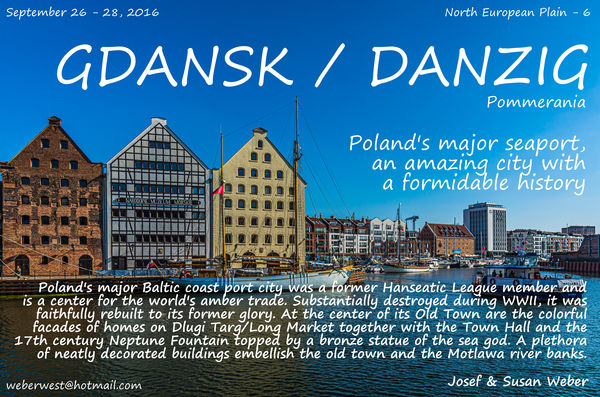
(Download)
2 - Map of the center of Gdansk indicating the places visited on this trip
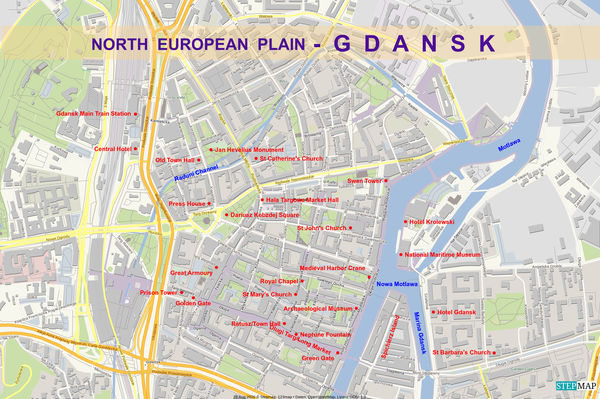
(Download)
3 - Early morning mood at the Gdansk Marina with the Amber Sky Ferris wheel reflecting in the calm waters
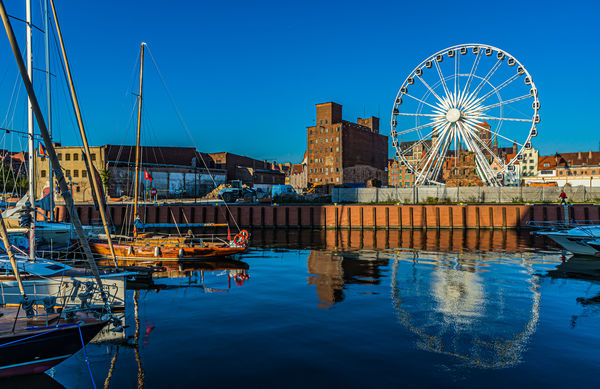
(Download)
4 - Gdansk Marina with the tip of the Spichlerz Island, left in ruins for 70 years, it is finally in the process of becoming rejuvenated in a grandiose fashion
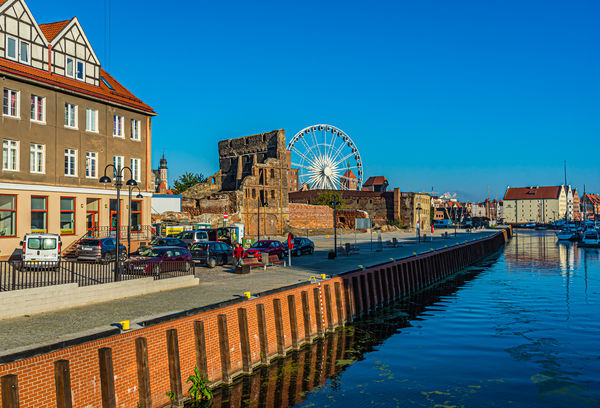
(Download)
5 - The "Milk-Can-Tower" (early 16c) at the Gdansk marina
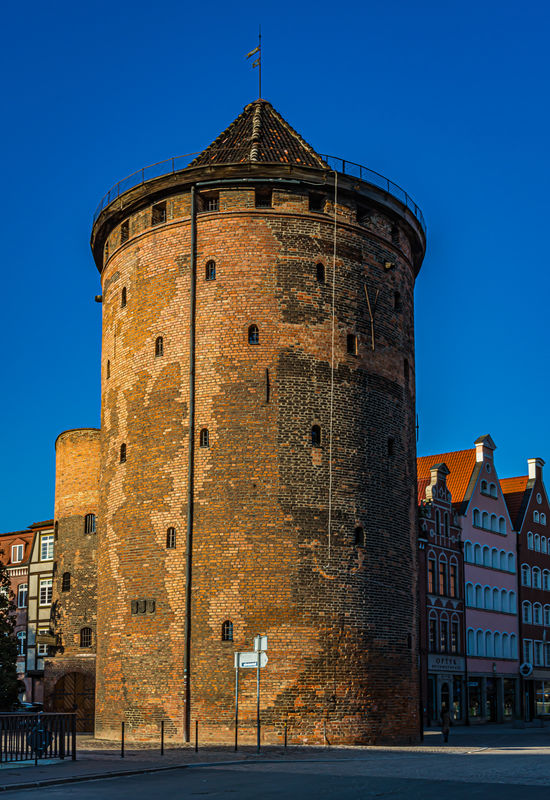
(Download)
6 - Early morning view from the Green Bridge south to the houses along the Motlawa river
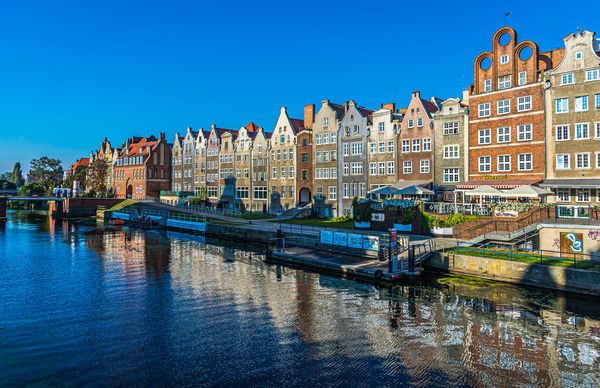
(Download)
7 - Early morning view of the Green Gate building (1560's) situated between Dlug Targ/Long Market and the Motlawa river
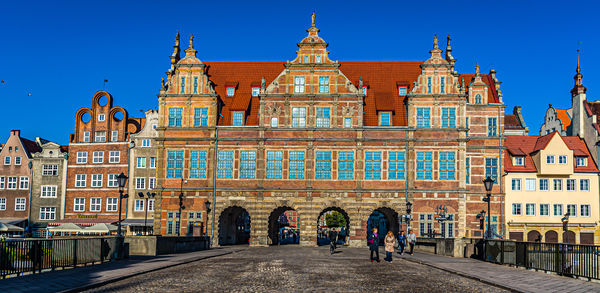
(Download)
8 - Detail of the upper part of the Green Gate building
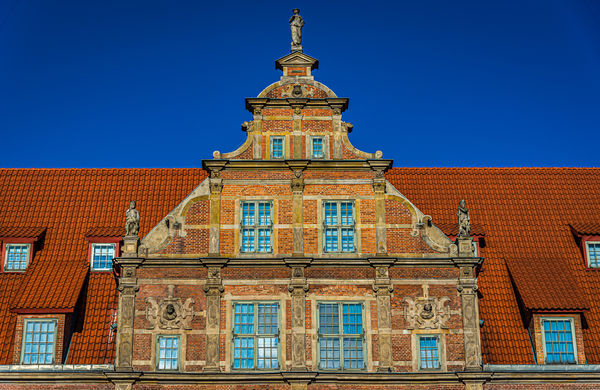
(Download)
9 - Close-up of the upper part of the Green Gate building
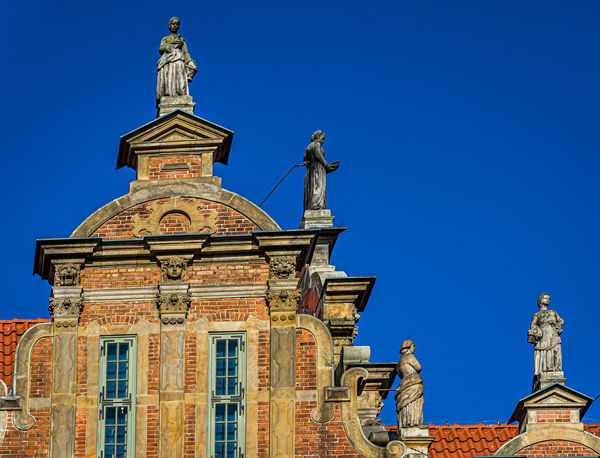
(Download)
10 - Early morning view of the Green Bridge and Green Gate at left and adjacent buildings to the north along the Motlawa river
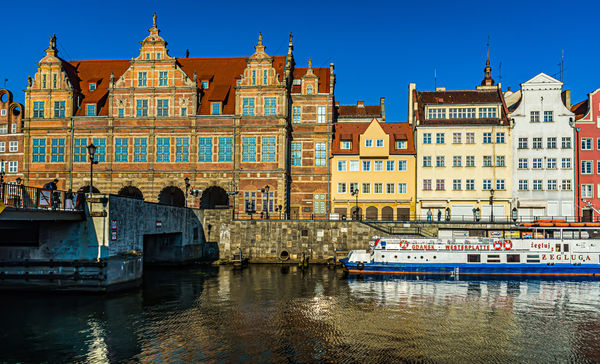
(Download)
Jul 10, 2021 10:56:20 #
Jul 10, 2021 11:06:06 #
Jul 10, 2021 11:15:37 #
DaveO wrote:
Fine job!
Thank you very much Dave for looking in on my long-running travelogue and your kind comment - welcome to the tour! Joe
Jul 10, 2021 11:41:31 #
Excellent collection! those giant ferris wheels are popping up all over the globe.
Jul 10, 2021 11:42:47 #
Jul 10, 2021 11:43:19 #
Jul 10, 2021 11:48:19 #
A fine set Joe. Beautiful early morning light really enhances the images. The sky is so blue too. You provided so much history and information in your narrative as well. Thanks for sharing.
Jul 10, 2021 11:52:38 #
jerryc41 wrote:
Excellent collection! those giant ferris wheels are popping up all over the globe.
Thank you Jerry for looking in on the tour again and your kind comment. Yes, these giant wheels are becoming quite popular.
Jul 10, 2021 11:54:58 #
angler wrote:
Excellent as always Joe.
Thank you Jim for your kind words, it is always good to see your comments!
Jul 10, 2021 11:57:29 #
Longshadow wrote:
Nice!
Any idea for what the tower was used?
Any idea for what the tower was used?
Thank you Bill - apparently this is one of the guard towers that used to protect the warehouses on the island. Here is a link to a post I found:
https://www.inyourpocket.com/gdansk/stagiewna-gate_146514v
Jul 10, 2021 12:02:43 #
Vince68 wrote:
A fine set Joe. Beautiful early morning light really enhances the images. The sky is so blue too. You provided so much history and information in your narrative as well. Thanks for sharing.
Thank you Vince. Glad you enjoyed this set - I realized upon our arrival on the evening before that the beautiful buildings along the Motlawa would be best seen in the early morning light, so we got up uncharacteristically early that morning and just had a ball with that wonderful light!
Jul 10, 2021 12:04:07 #
Jul 10, 2021 12:06:30 #
Earnest Botello wrote:
Great series, Joe.
Thank you Earnest, glad you enjoyed this introductory set to Gdansk.
Jul 10, 2021 12:07:03 #
weberwest wrote:
Thank you Bill - apparently this is one of the guard towers that used to protect the warehouses on the island. Here is a link to a post I found:
https://www.inyourpocket.com/gdansk/stagiewna-gate_146514v
https://www.inyourpocket.com/gdansk/stagiewna-gate_146514v
Neat, thanks!
If you want to reply, then register here. Registration is free and your account is created instantly, so you can post right away.

